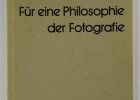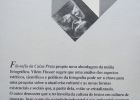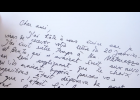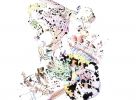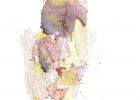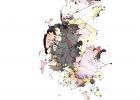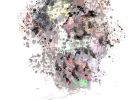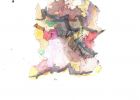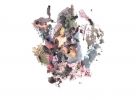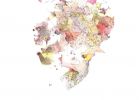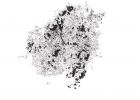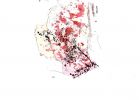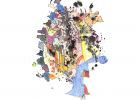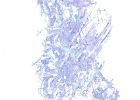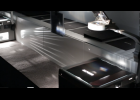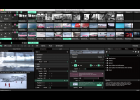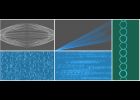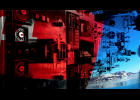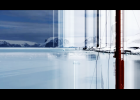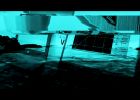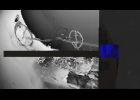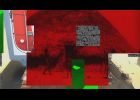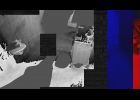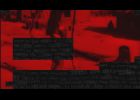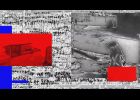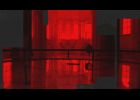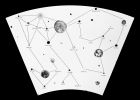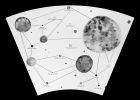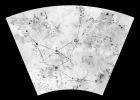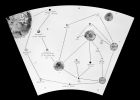Flusser Studies 30 - November 2020 / Vilém Flusser and His “Languages”
I. The Limits of Translation
Gestural translations from within the (post)digital: a Flusserian analysis of phonic gestures
Bridging the gap between Vilém Flusser’s theorising around language and work on gesture, this paper will examine the collection of gestures that form a constituent ‘vocabulary’ of our mobile phone use. The presented research examines a wide array of gestural taxonomies that take the form of dictionaries and notations which have been used in attempts to define such developing vocabularies. However, the paper is critical of these taxonomies as it argues they reveal a central problematic at the heart of any gestural vocabularies: the reduction of the body into the biomechanical; an assortment of weighted pulleys and levers. As a result of this, these gestural taxonomies are shown to create technical images of the body reducing it further to nothing more than a functionary of an apparatus. In response to these limitations implicit within such taxonomies, the paper reconsiders today’s developing gestural language in terms of the writing of Flusser. It argues that his work allows for gesture to be examined as phenomena, and in viewing these gestures as situated and witnessed phenomena, it becomes possible to perceive of them not simply as symbolic movements of the body, but rather as a form of translation. The paper then argues that what is being translated through these phonic gestures can be understood as a postdigital condition that has emerged following the alleged end of the digital revolution. To evidence these claims, the paper performs a gestural analysis of Luke Collins’s short film, Swiped (2019) that demonstrates an interaction between two individuals attempting to navigate a peculiar (post)digital situation.
Fiktions des Wissenschaft – Is Science Fiction Translatable? or is Translation a Science Fiction?
Vilém Flusser’s 1988 short essay Science Fiction explores two strategies of science and fiction as science, and provides clues to his process of translating and retranslating his own work. Flusser explains two different praxes that lead to an essential paradox, and that this two-sided approach is equivalent to Leonardo da Vinci’s fantasia essata, an ‘exacting fantasy’. For Flusser, Science Fiction is a ‘Technik’ in the truest sense of the word, and his theory and praxis of science fiction can be applied to his use of translation. While he allows for an ‘inexactitude’ in science, science fiction and translation – an ‘Ungenauigkeit’ that allows a space for exploration – he still engaged in translation, using this practice throughout his career. It is odd then, that he did not take the time to translate and reevaluate his 1988 lecture Science Fiction. Both translation and science fiction can exist as a kind of Technofantasy as proposed by Don Ihde, but one where Flusser’s two fiction-in-science strategies to approaching truth (“Wahrheit”) in science (“Wissenschaft”) are analogous to Hans Vaihinger’s two categories of fictions: ‘figments’ as imaginary fantasy, and ‘fictions’ as falsifiable conjecture. Both allow for a more nuanced sliding suspension of disbelief that is liminal and active in the human practice of finding meaning in information. This is not a subliminal hidden individual practice, nor is it hyper-liminal collective-unconscious of an overall audience knowledge – but both. This double-edged practice is baked into how narrative and scientific method’s dialectic have evolved and replicated across history particularly through translation. Using both Vaihinger’s Philosophy of ‘As-If’ and Ihde’s conceptions of Postphenomenology this research seeks approaches to translation and science fictions in Flusser’s works. It will then reconnect to the original 1988 essay linking Flusser’s ideas of science fiction and translation and the struggle with translating thought, science and fictions.
Für eine Philosophy of Caixa Preta. Analyse textuelle critique des différentes versions du livre de Vilém Flusser Pour une Philosophie de la Photographie et petite histoire de ses éditions
Towards a Philosophy of Photography was written by Flusser in three different languages, and there are important differences between the texts in German and English, and the text in Portuguese: the latter puts more emphasis on the black box and spells out that photography is a pretext to study the apparatus. However, all translations without exception were made from the German and English versions and therefore do not do justice to the development of Flusser's thinking in 1985 when he wrote the Portuguese version. Based on a textual analysis of these different editions and of the third-party translations (a critical approach so far little applied to Flusser's books), this essay suggests combining the different versions written by Flusser to arrive at a comprehensive text reflecting better his thinking. In doing so, it raises the question of power and languages, and proposes some principles to confront it.
Slouching Towards the Abyss
Design theory is a somewhat new sub-discipline in which Flusser’s legacy remains largely unnoticed or perhaps overlooked. This is especially disappointing since his theoretical musings on design and applied theory are of extreme relevance to design scholars and practitioners alike. Flusser’s ability to perceive theoretical vistas of our material surroundings add an interesting layer to his overall perception of the human condition. What’s more, his tendency to navigate between etymology, socio-cultural aspects and everyday phenomena represents an almost exact definition of contemporary design. In this paper we tackle two major issues. Firstly, Flusser’s ability to cut back and forth between languages as a means to discuss various types of subject-matter, which we term the “linguistic chameleon” ability. Secondly the unique trait of sleep - its inability to “be designed”, leaving each of us to fend for ourselves, navigating the night’s terrors. The two issues are bound together, or perhaps navigated through, in discussion on Hebrew which, despite its frugality, is arguably the most suitable language to tackle the physiological (and psychological) process of sleep.
II. Correspondências
Vilém Flusser, Theon Spanudis: their languages
Vilém Flusser and Theon Spanudis were both immigrants in São Paulo in an effervescent moment of the city. Theon Spanudis was a Greek-Brazilian art collector, poet and psychoanalyst, whose personal documents and works of art were donated to the University of São Paulo. Archive documents from Vilém Flusser Archiv in Universität der Künste Berlin and from Theon Spanudis in Instituto de Estudos Brasileiros formed a dialogue between them through letters that is very useful to understand the relevance of language not only in their work but also in their social environment. Their letter-based communication probably started during the 1970s, when Flusser went back to Europe. Most of the documents are in German. But this was not a special case in the group they belonged while in São Paulo, once they were both friends of the artists Mira Schendel, another immigrant, and Niobe Xandó, who was a Brazilian painter married to Alexander Bloch, the Czech philosopher who is celebrated in one of the chapters of Flusser’s autobiography “Bodenlos”. Language was the medium but also the theme of their letters. Language - especially German - was a kind of space where the sociability of them happened. This presentation aims to investigate how languages impacted the presence of those figures in a Brazilian cultural scene and how those figures managed languages in the way they did autotranslations, textual experiments and written theories.
From Ecstasy to Melancholy: An epistolary journey recounting Flusser’s unrealized proposal for the Art & Communication nucleus in the 1973 XII Bienal de São Paulo
This essay presents a brief commentary about Vilém Flusser’s activity as a technical advisor for the 1973 XII Bienal de São Paulo through an archive of unpublished correspondences. This archive reveals Flusser’s persona as a prolific letter writer and gives us a glimpse on his attempt to turn “theory into praxis” by articulating a complex and forward-looking communicological proposition to reorganise the Bienal in line with developments in new media art practices and telecommunications infrastructures at the time. The aim was to critique notions of art display, spectatorship and production, through a utopian, radical, and collective laboratory with artists using communicative practices. Most of the letters were written between 1971-1973 while Flusser was working in Europe, in part to garner international approval and participation for the event. The correspondences also testify to a period of inflection in Flusser’s approach to the visual arts and for the ambitious outlook on artistic practices and their discursive potential for social and political transformation. I suggest that Flusser has used a curatorial approach as a means to embed his philosophy in everyday life through the medium of the art exhibition. Flusser’s work was cut short due to funding issues and other contingencies before the proposition could be fully realized, leading ultimately to his permanent second exile in Europe in late 1973.
Seismic Cyst: Vilém Flusser’s Journalistic Philosophical Quasi-Poetry and Oswald de Andrade’s Telefonemas in the Corpus of Brazilian Philosophy
This paper relates Vilém Flusser's and Oswald de Andrade's philosophical approaches by examining and comparing Flusser's quasi-poetical way of writing philosophy in newspapers articles of the 1960s with de Andrade's Telefonema, newspapers articles of the 1940s and 1950s. It is analyzed their supposedly minor texts, setting the principle that the manifestos and the large theoretical novels that both composed could be present as a horizon of analysis. If it was to work with minor authors within a minor philosophy, it would be necessary to go even more to the micro. The purpose was to follow the fleeting traces of their literary-philosophical machines and their (dis)articulation with (neo)colonial powers. The assumption is that there is a similarity in the way they deal with the question of otherness, which is manifest in the approach that they do towards philosophy, literature and journalistic activity. They not only share several criticism and frustrations about the philosophical program that was intended to be established in Brazil but are also to be seen as exploring the boundaries between thought and literature, announcing and expecting philosophies to come.
III. Amplified Language
Flusser’s Demon.Writing Under the Eye of an Automatic Critic
In our word-processors and our social networks, algorithms read and judge our writing in increasingly sophisticated (and invasive) ways. This paper positions Flusser as a key theorist in the conceptualization of computer-mediated writing. In Into the Universe of Technical Images, Flusser glimpses the potential for “automatic critics” to filter and censor writing at a mass scale, not merely correcting infelicities but stringently enforcing all sorts of aesthetic virtues. For him, such a critic would be a “demon” that, in the style of the demon described by James Clerk Maxwell’s famous thermodynamic thought-experiment, would impact language at the level of its entropy. After considering the (slippery, conflicting, and provocative) ways that Flusser uses thermodynamic principles and information theory to imagine an automatic critic that encourages (a statistically-determinable kind of) creativity, I then consider my own example of a “Flusser’s demon.” StyleVise is an automatic critic that I designed to force me to use more complicated syntactic structures. I describe the workings of this system and think through what our linguistic universe would look like if such automatic critics were widespread. While Flusser foresees a future in which human judgment has been almost totally outsourced to machines, I worry about a different future, a “demonic arms race” in which we competitively scramble to acquire the most sophisticated artificially-intelligent writing assistants. Despite or because of this worry, I call for practitioners of “electronic literature” to turn towards the important task of designing demons that mediate our minds in ways that are beneficial not just to the individual but also to the public.
Reversing the vectors of meaning. The diagrammatic language of Vilém Flusser
According to his own cultural analysis, Flusser was a man of yesterday. He, who wrote nearly every day of his life, was himself subject to the “textolatry” of modernity. A modernity, though, which would soon shift into a new epoch which Flusser and others had given similar names: post-histoire, post- modernity, information or telematic society. In this new situation, according to Flusser, written text would become a marginal code, soon to be superseded by the “technical image” as universal means of communication and information storage. Thus, Flusser described authors like himself, which would stay engaged with text, as “the new illiterates” of the upcoming age. But although Flusser was a man of the written word, I will argue that there was at least one type of sign system with which he also operated frequently and which can be linked to his image heuristics: the diagram. Scattered over his manuscripts, letters and notes, over 160 diagrammatic sketches can be found in the Vilém Flusser Archive. Compared to the thousands of documents in the archive, this seems to be a small number. But his diagrammatic sketches are not only interesting considering the nearly exclusively textual character of Flusser’s legacy; they can also be described as Flusserian technical images. According to the semiotic definition of the diagram by Charles S. Peirce, diagrammatic signs constitute a specific subclass of the icon: A diagram resembles its object not by visual but structural similarity. By drawing a diagram, one proposes a hypothesis about the structure of its object, thus manifesting an abstract concept as a concrete sign. Here we come close to Flusser’s notion of technical images as projections of abstract models. Following up on this comparison, the paper pleas for a non-trivial relation between Flusser’s heuristic of the technical image and his diagrammatic practice.
Art and Language in Vilém Flusser’s Brazil: Concrete Art and Poetry
Paradoxically, Flusser felt exiled to the periphery of intellectual life and culture by his forced migration to Brazil in 1940, but he was actually arriving at a center of innovation in art and writing. The Museu de Arte Moderna opened in São Paulo in 1948, the Museu de Arte Moderna do Rio de Janeiro in 1949, and the inaugural São Paulo Biennial in 1951. Concrete art intersected with Concrete poetry and Flusser was profoundly impacted by these developments. Flusser was impressed by the formal layout of Concrete art and poetry and their approaches to space, color, and typography. Concrete painting and poetry served as proto- interfaces or screens and offered what poet and theorist Haroldo de Campos called a “new dialogical relationship” with “imperial” languages. These developments caught the attention of Max Bense, the information-aesthetics theorist who served as an early and important model for Flusser, and who exhibited Concrete poetry, as well as computer-generated drawings and the work of Flusser’s friend Mira Schendel, in the Study Gallery at the University of Stuttgart. Flusser translated a fragment of Haroldo de Campos’ Galáxias for Bense’s and Elisabeth Walther’s experimental journal rot, and the enduring impact of Concrete art and poetry can be glimpsed in Flusser’s later concepts: the “superficial” reading of technical images, non-linear “post-historical” thinking, and the idea that philosophy itself would be practiced in images rather than written words.
IV. Vampyroteuthis infernalis: Le vampire des abysses
Flusser’s Vampyroteuthis Infernalis: Homo Sapiens’ Posthuman Future?
Hsu’s contribution focuses on Flusser’s mock treatise and report on reputedly one of the most elusive animals in the ocean, the vampire squid. Vampyroteuthis Infernalis is interpreted as a literary text, specifically regarding the narration’s polyphony – ironic, satirical, elegiac, awe-struck; the vampire squid in this narrative is cast in the role of a gothic monster that glides, darts, slips into darkened recesses and away from the hunter-marine biologist, naturalist, or the philosopher demanding to know what it knows. In Flusser’s ironic telling, the creature possesses many fascinating qualities, and, like Humboldt, we want to capture and study this alien being. Yet, the narrator evinces both desire and aversion towards this creature that is so strange as to be unassimilable in our Imaginary, except as a monster. Flusser’s text turns on its head the consumptive and assimilative impulses undergirding all colonial adventures. Vampyroteuthis Infernalis, like the vampire squid, evades conventional taxonomy; arguably, Flusser’s text is a landmark in the emerging field of animal studies. Next, Hsu enlists the help of Martin Buber and Donna Haraway in examining Flusser’s ontological questions brought forth by the narrator’s confrontation with the irredeemable squid/other. The presentation concludes with a (mock) conversation among Buber, Haraway, and a vampire squid.
Vampyroteuthis as a bioluminescent lighthouse to think under the livings. Some mutations: From 1981 to 1991
This contribution is about a translation of the book Vampyroteuthis Infernalis into a dialogic media. In Vampyroteuthis Infernalis, Vilém Flusser describes an abyssal creature, opposite in every point with humans. From 1981 to 1991, the book mutates within the writing process of Flusser engaging with letters, oral dialogues, essays, courses and translations. There is a genealogy of the Vampy and of the Vampyroteuthian model from the French version to the Brazilian one. I will call this model Vampy, a borrowed term from the relationship between Louis Bec and Vilém Flusser (Marburger 2016). The article emphasizes Flusser’s programmatic vision in the Vampyroteuthis. How can the philosophy of Flusser’s programs, embodied in the Vampyroteuthis, serve us as a lighthouse in the “moment of the living” (Worms 2016) that we are going through nowadays? Taking into account the three different versions of the vampy, from the French to the Brazilian one, I propose to contextualize the Vampyroteuthis inputs into the thinking of the livings. In this regard, the French version, which is the first unpublished version, is a typescript given as a gift to his friend, the artist Louis Bec. It deals with an important scientific context. We have to note the existence of the French molecular school of biology with Jacob and Monod, and the presence of thinkers such as Bergson and Canguilhem. In the late 1960s, biology is redefined by DNA discovery and the notion of code: that’s the historical moment of molecular biology. It changed our entire way of seeing living beings. However, it may happen that this moment also lacks the critical point that Flusser made about our programmatic condition of existence.
Manifesto Anthrobscene
In 1940 on the onset of WWII, Vilém Flusser, his Czech family lost to German concentration camps, left Europe for Sao Paulo to become a Brazilian citizen, where he wrote and taught philosophy until 1972. In 1987, Flusser wrote Vampyroteuthis Infernalis, which one reviewer of the English translation compared to the writings of Jorge Luis Borges. In the spirit of Borges and Flusser, and set in Brazil, Yamashita’s presentation depicts the legacy of colonial processes that continue to destroy native populations, human and non-human, and to conceive of earth as inanimate, blind, mute, and utterly insensible. Divided into two parts, part one re-imagines Oswald Andrade’s “Manifesto Antropofágico” and Jonathan Swift’s “A Modest Proposal,” countering the empiric construction of native people as “savages” and innate cannibals. Part two re-composes a story told by a parrot, whose ancestor had been separated from her mate by Alexander von Humboldt. In 1799, Humboldt is said to have sent a parrot home to Prussia, the parrot being the last keeper of the language of an extinct Amazonian tribe. The descendant parrot and her interlocutor reconstruct a fabula composed in the register of dark humor about the deepest recesses of a forest (or the human id). In this primordial forest—reminiscent of a staging of Pina Bausch’s “Rites of Spring”—a fecund exchange occurs between sightless Mother Tongue and a ravenous Father Penis who “ate the eyes of everything.”
V. Angenommen
From Language to Communication – Vilém Flusser’s path from language philosophy to communication and media theory
This article reconstructs Vilém Flusser’s first academic field of research, the philosophy of language, documented by the two books, Language and Reality and Philosophy of Language, that arose from his initial interest in language in general; and how these early probings were preserved in the later course of his work when his focus changed from language to communication and mediation. It fleshes out concepts that represent a continuity in his work, such as sign, meaning and symbol, information, knot, entropy, discourse, the technological world, and dialogue and conversation; all of this being based on a wider concept of language that encompasses not only speech but also sound, images, and symbolic forms in general. It intends to shed light on the continuity in Flusser’s work over the course of its progress and changing focuses.
Towards no body – traces of Flusser’s psychology
Pivotal in Vilém Flusser’s language philosophy and fundamental for his media theory are his reflections on psychology. Rooted in his first unpublished work Das 20. Jahrhundert [The 20th Century] unfolding in Language and Reality and summarized in The History of the Devil Flusser’s thoughts on psychology meander from his early writings to his late articles. In the two articles “Wahrnehmung” [Perception] (1990) and “Das Universum der Technik als Spiegel und/oder als Verschleierung menschlicher Absicht” [The Universe of Technology as Mirror and/or Concealment of the Intention of Man] (1987), both published in the journal “Praktische Psychologie”, Flusser connects the linguistic ontology of perception to the psychological aspect of (digital) information. In Language and Reality Flusser says: “data are being compiled and compared in order to be computed. We are a generation of accountants who are in the process of becoming a line of computers” (2018:9). Flusser categorizes Western languages as fusional, logically organized and translatable. Through science and philosophy, they have the potential to be transformed into an universal, abstract, artificial language (2018: 37-39). In his article, Eckhard Geitz connects the psychological dots in Flusser’s thinking – from his early philosophical writings to his information philosophy and the call for a new anthropology in his late texts.
VI. Artistic Statements
The Anti-Archive as a spatial design tool for the continuous destruction and reconstruction of memory
The installation Anti-Archive in the Vilém Flusser Archive (Berlin) establishes a design posture, a method for conveying content from memory spaces that rejects the reproduction of historical discourses. Instead, it seeks to show the ruptures and gaps in history in which each individual can endlessly reconstruct his memory. There are infinite anti-archives in every archive.
Notes on Antarctica Tempo
This article is the outcome of an audiovisual performance proposed for the Conference Vilém Flusser and His “Languages.” It presents the concept, aesthetic and technical choices on Antarctica Tempo, a Live Cinema work of art and science resulting from a 60-day expedition to Antarctica. The perception of this place and the pace of the trip are mixed with scientific research, my subjective view, and control within the military environment. It is a mixture of codes – software and language – that try to translate the experience lived in that distant place. The language I want to portray here is the technical image, the remix of this imagined place and tempo.
L’inter-code
In L’inter-code, a pseudo-random algorithm controls the appearance of zones of images and zones of text in mutual exclusion over the screen. The images include animations based on 3D models of objects exhibited in the Musée des Arts et Métiers in Paris: astronomical instruments which measure the infinitely big, a cyclotron which probes the subatomic world and above all, photo cameras adapted to the measure of space (photogrammetry). The images also include footages taken by the German ethnologist Theodor Koch-Grünberg in 1911 while living with the Taulipang tribe in Brazilian Guyana. The texts where extracted from the work of the philosopher Vilém Flusser, Towards a Philosophy of photography, which inspired this work. Strengthened by the soundtrack, this animation opposes Images and Texts in line with the ideas of Vilém Flusser: texts and images confront one another in the representation of the real world. This dialectical relationship, whose synthesis is yet to be discovered, is matched in the video by another opposition: tribal men living in equilibrium with nature, contrasting with the divergences of technical progress. By representing the biased relationship mankind maintains with the real when it is coded by texts and by images, L’inter-code seeks to question photographic image, not as the neutral product of a technique but as a complex construction that embeds a risk: the danger of increasing the distance between mankind and the world he inhabits. L’inter-code questions the possibilities and limits of science and its materialization in technology.
Al-Zahir
The Zahir in Jorge Luis Borges’ story is an object by which men become obsessed and are no more able to see anything beyond it. The mystery: why does the Zahir has this attractor power? Borges questions himself the reason why Tennyson said that if we could understand one single flower, we could understand what the world is. “Perhaps he was trying to say that there is nothing, however humble, that does not imply the history of the world and its infinite concatenation of causes and effects.” And then the Zahir would also have this potency of revealing the nature of being and existence. I conciliate Deleuze’s object’s ontology and Flusser’s concept of virtuality with aspects of the Sufi philosophy in order to investigate how a single object manifests itself, what are its potencies of existence beyond the real and the relations this object maintains with other systems to comprehend the whole through it.
Camera and the Mirror, a post-manuscript
In “Camera and The Mirror”, Lalou analyzed the work of those major white male figures that made a significant stance on the role of camera apparatus in film production, planning her slow physical death as an artist-at-work, and her transference to a three-model algorithm, after fifteen years of producing works that incorporate cinematic and surveillance apparatuses as her tools, with references to the politics of the viewer. The first chapter is based on her own first ever feature film recorded as a single shot “The Dialogue”, moving the narrative through the basis of those major works of film history “Parallel I-IV” (2008-12), “Salaam Cinema” (1995) and “Le Mépris” (1963) along with Flusser’s writings on the functions of the apparatus. By marking an index of cameras demonstrating the ideas behind their medium, and by scrutinizing the ingenious of each film, she directs a manual towards freedom from algorithmic governance; where the relation between camera, view and actor, subject and object is foregrounded and destabilized. This essay is a non-linear narrative text, an attempt of a post-manuscript, aligning the writing of the video essay tetralogy “Camera and The Mirror” (an experimental documentary that involves the relation of the camera’s role in the animated experience of the viewer) with an analysis of the function of the medium in our contemporary surveilled networked life. The post-manuscript was born by extracting the documentary’s content out of the ‘black screen’ over layered by the unnatural voice sound of British Bot Selene. The text is typed on the ‘black screen’ by white Courier typesetting and extrapolates the significant films in Farocki’s, Makhmakbaf’s and Godard‛s research. It is an attempt to inaugurate thoughts in a dialogue with Vilém Flusser’s Post-History, working towards ‘a manual of resistance’ against algorithmic governance, which questions the use of cinematic mechanisms in order to resist the authority of control of our data.
Temporal clusters
Temporal clusters are mind maps of Storelli’s artistic practice and used as a tool in her artistic research, chronomorphology: the study of how time develops and changes shape. One cluster is a diagram of notions. Concepts are positioned and connected in relation to one another to create a resonance between meanings. This form of diagrammatic writing is used by the artist to navigate through her thinking and to describe a possible correlation of ideas. Sometimes these associations have developed into artworks; sometimes they could become one.
Muju: Flusser’s approach to Eastern thoughts
Staying is accompanied by non-staying. Not staying anywhere - Muju(무주, 無住) in Zen-Buddhism directs to leave all forms of obsession, and at the same time to change without sticking to oneself. With the narration explores the connotation of ‘habitat’ reflecting studies of mind as well as socio-cultural context, the video induces meditative appreciation with the ambiguity of natural-artificial image and time.
Open Contribution
Da raiva / De la rage / On Rabies / Von der Tollwut - Présentation de De la rage de Vilém Flusser / Presentation of On Rabies by Vilém Flusser / Zu Vilém Flussers Von der Tollwut
In this 1969 article, Vilém Flusser explores the relationship between the rabies virus and humans, considering first how the virus “sees” man, and then analyzing the hierarchy between humans and the virus according to three criteria, genetical, structural and behavioral. He concludes that the best criterion for such a hierarchy between species is the degree of determination and openness of a given biological structure.
